上了建築旅行的癮-All about Architecture
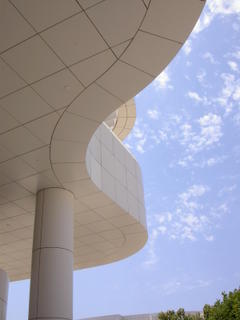 建築的體驗, 難以透過其他的媒介, 只有親身蒞臨其中, 才得真正感受.
建築的體驗, 難以透過其他的媒介, 只有親身蒞臨其中, 才得真正感受.因此, [為建築而旅行]之事, 就成了訓練一個建築人的必經之途. --- 陳世良
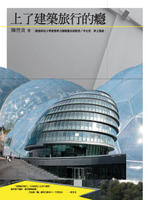 好書介紹: "上了建築旅行的癮"
好書介紹: "上了建築旅行的癮"Ajoutour>>>
這是個人旅遊之便,所欣賞到偉大的建築,感動之餘所整理的網誌.
 建築的體驗, 難以透過其他的媒介, 只有親身蒞臨其中, 才得真正感受.
建築的體驗, 難以透過其他的媒介, 只有親身蒞臨其中, 才得真正感受. 好書介紹: "上了建築旅行的癮"
好書介紹: "上了建築旅行的癮"
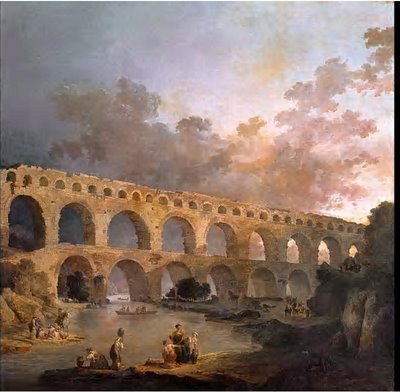
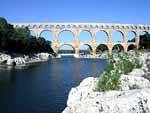 The Pont du Gard, part of the famous Roman aqueduct remains, was built under the emperor Claude, around 50 AD. At this time, Nîmes (or Nemausus, its roman name) was an important provincial town and had been so for nearly a century. First, Caesar, then Augustus contributed to Nîmes development by endowing it with various city walls and monuments. However the fountain, which had certainly contributed to settlements from the sixth century B.C onwards, was no longer adequate for the town’s expan
The Pont du Gard, part of the famous Roman aqueduct remains, was built under the emperor Claude, around 50 AD. At this time, Nîmes (or Nemausus, its roman name) was an important provincial town and had been so for nearly a century. First, Caesar, then Augustus contributed to Nîmes development by endowing it with various city walls and monuments. However the fountain, which had certainly contributed to settlements from the sixth century B.C onwards, was no longer adequate for the town’s expan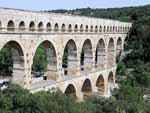 sion and its water needs. So the Nîmes authorities decided to create a water conveyance but they had to find a sufficiently plentiful source of water that would have both a regular flow and good quality water. The streams, rivers and waterways, including the river Gardon, were ruled out due to the irregularity of their flows. The source in Eure fulfilled the conditions. Therefore the Romans built the aqueduct from Uzès to Nîmes. The first leaks appeared as soon as water ran through the aqueduct and reducing the slope between Vers-Pont-du-Gard and Remoulins caused the reservoir to overflow. The height of the canal was raised for almost six kilometres and the bridge structures in this area were reinforced, except for the Pont du Gard’s. It seems that drinkable water was transported through the aqueduct until the first half of the third century A.D ensuing a period of illegal extractions for countryside irrigation.
sion and its water needs. So the Nîmes authorities decided to create a water conveyance but they had to find a sufficiently plentiful source of water that would have both a regular flow and good quality water. The streams, rivers and waterways, including the river Gardon, were ruled out due to the irregularity of their flows. The source in Eure fulfilled the conditions. Therefore the Romans built the aqueduct from Uzès to Nîmes. The first leaks appeared as soon as water ran through the aqueduct and reducing the slope between Vers-Pont-du-Gard and Remoulins caused the reservoir to overflow. The height of the canal was raised for almost six kilometres and the bridge structures in this area were reinforced, except for the Pont du Gard’s. It seems that drinkable water was transported through the aqueduct until the first half of the third century A.D ensuing a period of illegal extractions for countryside irrigation.
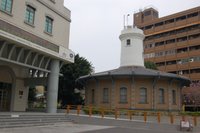
 由內到外依序為風塔、環形通道及環形事務空間, 簡潔的動線連貫不同機能的事務空間,最內一圈往上延伸成為圓筒塔,上面擺各種儀器;內圈與中間圈為走道;中圈與外圈間原來則是辦公處所。俗稱「胡椒管」的中央風力塔為收分狀煙囪造型之磚造承重牆, 上下端部以層層出挑的簷口作為收頭。除中央圓塔外,其餘部分上鋪屋瓦,瓦壠呈十八條放射狀排列。斜屋頂屋瓦日治時期使用黑瓦,光復後採用水泥瓦及鬼瓦,而其屋面乃由十八根大樑,由中央圓塔內環牆之磚疊澀上緣架設, 經中環牆頂部在塔於外環牆上而成。就整體外環牆牆面在日治初期僅飾以灰泥,直至日治中晚期才改以十三溝面磚。現今牆面的構成元素除了整體的十三溝面磚外還包括了附壁柱、門窗、圓拱門楣及拱形窗楣。另外,測候所的基臺高95公分, 其中附壁柱下緣為石造基座,柱腳及外環牆下緣同為外凸之石材連接十八邊形,石材下方則為外飾洗石子。
由內到外依序為風塔、環形通道及環形事務空間, 簡潔的動線連貫不同機能的事務空間,最內一圈往上延伸成為圓筒塔,上面擺各種儀器;內圈與中間圈為走道;中圈與外圈間原來則是辦公處所。俗稱「胡椒管」的中央風力塔為收分狀煙囪造型之磚造承重牆, 上下端部以層層出挑的簷口作為收頭。除中央圓塔外,其餘部分上鋪屋瓦,瓦壠呈十八條放射狀排列。斜屋頂屋瓦日治時期使用黑瓦,光復後採用水泥瓦及鬼瓦,而其屋面乃由十八根大樑,由中央圓塔內環牆之磚疊澀上緣架設, 經中環牆頂部在塔於外環牆上而成。就整體外環牆牆面在日治初期僅飾以灰泥,直至日治中晚期才改以十三溝面磚。現今牆面的構成元素除了整體的十三溝面磚外還包括了附壁柱、門窗、圓拱門楣及拱形窗楣。另外,測候所的基臺高95公分, 其中附壁柱下緣為石造基座,柱腳及外環牆下緣同為外凸之石材連接十八邊形,石材下方則為外飾洗石子。
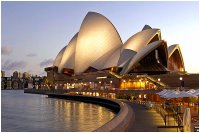
 "The construction of the beautiful freestanding, sculptural tripartite Opera House was one of the longest contractual sagas of the century. Sadly, architect Jorn Utzon became the scapegoat of a scandalous political affair and in 1966 withdrew from his project. Sitting on Bennelong Point, virtually in the Harbour and overlooked by the great Sydney Harbour Bridge, the Opera House is completely exposed, as three-dimensional as the orange segments its forms are based on. It is all roofs with an imposing base. These were made possible by Ove Arup.
"The construction of the beautiful freestanding, sculptural tripartite Opera House was one of the longest contractual sagas of the century. Sadly, architect Jorn Utzon became the scapegoat of a scandalous political affair and in 1966 withdrew from his project. Sitting on Bennelong Point, virtually in the Harbour and overlooked by the great Sydney Harbour Bridge, the Opera House is completely exposed, as three-dimensional as the orange segments its forms are based on. It is all roofs with an imposing base. These were made possible by Ove Arup. 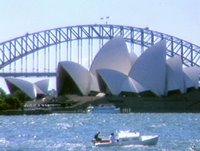 Originally the winner of an international open competition in 1957, it was a scheme that broke most of the rules. It was finally completed in August 1973 by other hands under the direction of Peter Hall."
Originally the winner of an international open competition in 1957, it was a scheme that broke most of the rules. It was finally completed in August 1973 by other hands under the direction of Peter Hall."
 The Bavarian fairytale castle Neuschwanstein is the only German site still in the running for a list of new wonders of the world. The New Seven Wonders Foundation this week announced its group of 21 finalists — the last shortlist before the complete new list of seven wonders is announced January 1, 2007.
The Bavarian fairytale castle Neuschwanstein is the only German site still in the running for a list of new wonders of the world. The New Seven Wonders Foundation this week announced its group of 21 finalists — the last shortlist before the complete new list of seven wonders is announced January 1, 2007.  Based on a similar list of great monuments from classical antiquity, the campaign, initiated by Swiss adventurer Bernard Weber, is drawing attention to the world's greatest works of man and raising money to restore and preserve them.The original seven wonders of the world were selected by Antipater of Sidon in 200 BC and were intended as a kind of travel guide for his fellow Mediterranean travelers. It comprised a group of popular sites located along the Mediterranean rim including the Lighthouse of Alexandria, the Temple of Artemis, the Statue of Zeus, the Colossus of Rhodes, the Hanging Gardens of Babylon, the Mausoleum of Halicarnassus, and the Great Pyramid of Egypt. Of the seven original wonders, only the Great Pyramid at Giza remains and is in the running for a spot on the new list. The New Seven Wonders campaign is not the first attempt to recreate a list of wonders for modernity. Similar lists have been compiled from groups such as the American Society of Civil Engineers theirs is a decidedly 20th century list and the Hillman Wonders of the World, which also features natural wonders and museums. But none has been quite so populist a movement as the New Seven Wonders, which includes voices from around the globe. A far less local bunch, the new list of 21 finalists includes sites as far-flung as the Great Wall of China, Machu Piccu in Peru, the head carvings of Easter Island, the Statue of Liberty in New York, and the Sydney Opera House. Neuschwanste in Eight German sites had made the list of top 100 sites, though none fared so well as Neuschwanstein, a 19th century Bavarian castle in Fuessen that has jumped from number 25 to 14 since TWIG first reported the story in December. Long one of Germany's most popular tourist destinations, hosting 1.2 million visitors annually, Neuschwanstein sits at the foot of the Alps and is the final destination on the Romantic Road leading through Bavaria. Though it was built in the latter half of the 19th century, it evokes a sense of medieval German life dominated by towering spired architecture and knightly staterooms, so much so that Walt Disney used Neuschwanstein as his inspiration for Sleeping Beauty castle at his Florida resort. Bavarian King Ludwig II built it, and they came, not just for the castle itself, but for the story of the mad king who frittered away the state's money with his three grand-scale palace projects and died mysteriously at Starnberg Lake before Neuschwanstein was completed. Vote for Neuschwanstein, and see the list of contenders at the "New Seven Wonders" website.
Based on a similar list of great monuments from classical antiquity, the campaign, initiated by Swiss adventurer Bernard Weber, is drawing attention to the world's greatest works of man and raising money to restore and preserve them.The original seven wonders of the world were selected by Antipater of Sidon in 200 BC and were intended as a kind of travel guide for his fellow Mediterranean travelers. It comprised a group of popular sites located along the Mediterranean rim including the Lighthouse of Alexandria, the Temple of Artemis, the Statue of Zeus, the Colossus of Rhodes, the Hanging Gardens of Babylon, the Mausoleum of Halicarnassus, and the Great Pyramid of Egypt. Of the seven original wonders, only the Great Pyramid at Giza remains and is in the running for a spot on the new list. The New Seven Wonders campaign is not the first attempt to recreate a list of wonders for modernity. Similar lists have been compiled from groups such as the American Society of Civil Engineers theirs is a decidedly 20th century list and the Hillman Wonders of the World, which also features natural wonders and museums. But none has been quite so populist a movement as the New Seven Wonders, which includes voices from around the globe. A far less local bunch, the new list of 21 finalists includes sites as far-flung as the Great Wall of China, Machu Piccu in Peru, the head carvings of Easter Island, the Statue of Liberty in New York, and the Sydney Opera House. Neuschwanste in Eight German sites had made the list of top 100 sites, though none fared so well as Neuschwanstein, a 19th century Bavarian castle in Fuessen that has jumped from number 25 to 14 since TWIG first reported the story in December. Long one of Germany's most popular tourist destinations, hosting 1.2 million visitors annually, Neuschwanstein sits at the foot of the Alps and is the final destination on the Romantic Road leading through Bavaria. Though it was built in the latter half of the 19th century, it evokes a sense of medieval German life dominated by towering spired architecture and knightly staterooms, so much so that Walt Disney used Neuschwanstein as his inspiration for Sleeping Beauty castle at his Florida resort. Bavarian King Ludwig II built it, and they came, not just for the castle itself, but for the story of the mad king who frittered away the state's money with his three grand-scale palace projects and died mysteriously at Starnberg Lake before Neuschwanstein was completed. Vote for Neuschwanstein, and see the list of contenders at the "New Seven Wonders" website.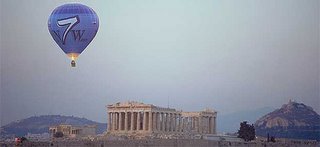 Links:
Links: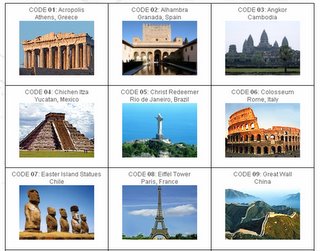
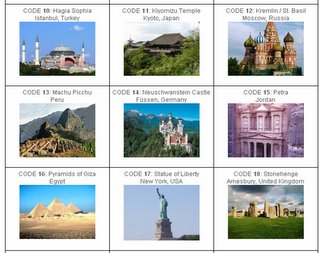


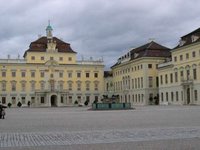 Eberhard Ludwig, the residence was transferred back to nearby Stuttgart. In 1733, when the construction phase had been completed, the baroque style was absolutely prevailing in Germany. Eventually, successors of Eberhard Ludwig modified the original design of the palace. Especially, Duke Carl Eugen of Württemberg (1728 - 1793) and King Friedrich of Württemberg (1754 - 1816) have to be mentioned.
Eberhard Ludwig, the residence was transferred back to nearby Stuttgart. In 1733, when the construction phase had been completed, the baroque style was absolutely prevailing in Germany. Eventually, successors of Eberhard Ludwig modified the original design of the palace. Especially, Duke Carl Eugen of Württemberg (1728 - 1793) and King Friedrich of Württemberg (1754 - 1816) have to be mentioned.
 這是位於美國加州橘郡剖負盛名的一個教會:水晶大教堂。如果五、六百年前的建築設計師透過建築這個視覺藝術品來傳遞神的屬性,那麼他們會建構出歌德式大教堂。不過當代的建築設計師,憑藉當代的建築技法與建築學觀點,或許就會建造出這麼一個由鋼骨與水晶玻璃所構成的教堂建築了.1980年9月,歷時12年,可容纳一万多人的水晶大教堂竣工,成为世界建築史上的奇迹与经典,也成为世界各地前往加州的遊客,必去瞻仰的勝景。水晶大教堂最终的造价为2000万美元,全部是羅伯舒勒博士一点一滴筹集而来的.
這是位於美國加州橘郡剖負盛名的一個教會:水晶大教堂。如果五、六百年前的建築設計師透過建築這個視覺藝術品來傳遞神的屬性,那麼他們會建構出歌德式大教堂。不過當代的建築設計師,憑藉當代的建築技法與建築學觀點,或許就會建造出這麼一個由鋼骨與水晶玻璃所構成的教堂建築了.1980年9月,歷時12年,可容纳一万多人的水晶大教堂竣工,成为世界建築史上的奇迹与经典,也成为世界各地前往加州的遊客,必去瞻仰的勝景。水晶大教堂最终的造价为2000万美元,全部是羅伯舒勒博士一点一滴筹集而来的. 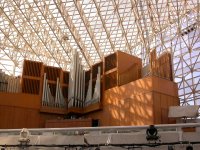

 Art Nouveau (French for "new art") is an art and design style that peaked in popularity at the beginning of the 20th century. Other, more localized terms for the cluster of self-consciously radical, somewhat mannered reformist chic that formed a prelude to 20th-century modernism, included "Jugendstil" in Germany, named for the snappy avant-garde periodical Jugend ('Youth') or "Sezessionsstil"
Art Nouveau (French for "new art") is an art and design style that peaked in popularity at the beginning of the 20th century. Other, more localized terms for the cluster of self-consciously radical, somewhat mannered reformist chic that formed a prelude to 20th-century modernism, included "Jugendstil" in Germany, named for the snappy avant-garde periodical Jugend ('Youth') or "Sezessionsstil" in Vienna, where forward-looking artists and designers seceded from the mainstream salon exhibitions, to exhibit on their own in more congenial surroundings. In Russia, the movement revolved around the art magazine World of Art, which spawned the revolutionary Ballets Russes. In Italy, "Stile Liberty" was named for the London shop, Liberty & Co, which distributed modern design emanating from the Arts and Crafts movement, a sign both of the Art Nouveau's commercial aspect and the "imported" character that it always retained in Italy. In Catalonia, the movement was centred in Barcelona and was known as "modernisme", with Antoni Gaudí as the most noteworthy practitioner. 右圖是慕夏設計的布拉格市民大廳.
in Vienna, where forward-looking artists and designers seceded from the mainstream salon exhibitions, to exhibit on their own in more congenial surroundings. In Russia, the movement revolved around the art magazine World of Art, which spawned the revolutionary Ballets Russes. In Italy, "Stile Liberty" was named for the London shop, Liberty & Co, which distributed modern design emanating from the Arts and Crafts movement, a sign both of the Art Nouveau's commercial aspect and the "imported" character that it always retained in Italy. In Catalonia, the movement was centred in Barcelona and was known as "modernisme", with Antoni Gaudí as the most noteworthy practitioner. 右圖是慕夏設計的布拉格市民大廳.
 台北101大樓除了擁有世界最高樓的美譽外,今天又拿下另一個世界第一!101內部兩部觀光電梯,經過英國金氏世界記錄見證中心認定下,成為目前世界上最快速的電梯,由地面直達
台北101大樓除了擁有世界最高樓的美譽外,今天又拿下另一個世界第一!101內部兩部觀光電梯,經過英國金氏世界記錄見證中心認定下,成為目前世界上最快速的電梯,由地面直達 89樓,只要37秒,相當於時速60公里。101辦公大樓在年底營運後,民眾也有機會搭乘世界第一快的電梯登上世界第一高樓,俯瞰大台北。由崇友實業安裝在台北101大樓的兩部東芝觀光電梯,是目前世界最快速的電梯,分速一千零一十米,相當於時速六十公里,比起第二名的日本橫濱地標大樓高速電梯分速七百五十米速度,遙遙領先。101高速電梯由地面直達八十九樓頂,高度約三百八十二點二公尺,只要三十七秒就可登臨觀景
89樓,只要37秒,相當於時速60公里。101辦公大樓在年底營運後,民眾也有機會搭乘世界第一快的電梯登上世界第一高樓,俯瞰大台北。由崇友實業安裝在台北101大樓的兩部東芝觀光電梯,是目前世界最快速的電梯,分速一千零一十米,相當於時速六十公里,比起第二名的日本橫濱地標大樓高速電梯分速七百五十米速度,遙遙領先。101高速電梯由地面直達八十九樓頂,高度約三百八十二點二公尺,只要三十七秒就可登臨觀景 層,為了解決電梯超高速行駛所產生的氣壓變化,廠商在電梯內部採用氣壓調節系統,這也是全世界第一部裝設艙壓調節設備的電梯,讓乘客可以舒適享受搭乘超高速電梯的樂趣。右圖是從台北101觀景台所拍攝的夜景.
層,為了解決電梯超高速行駛所產生的氣壓變化,廠商在電梯內部採用氣壓調節系統,這也是全世界第一部裝設艙壓調節設備的電梯,讓乘客可以舒適享受搭乘超高速電梯的樂趣。右圖是從台北101觀景台所拍攝的夜景.
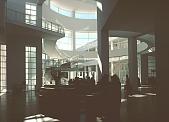
 The Getty Center, sometimes referred to as a campus, is comprised of six buildings: the Auditorium, North and East Buildings at the north and east sides, the Museum, Cafe and Research Institute on the south and western sides of the site. (See map on this official Getty Center site.) It is also sometimes called a modern "Acropolis" since it is spectacularly located on a 110-acre hilltop with a view south over
The Getty Center, sometimes referred to as a campus, is comprised of six buildings: the Auditorium, North and East Buildings at the north and east sides, the Museum, Cafe and Research Institute on the south and western sides of the site. (See map on this official Getty Center site.) It is also sometimes called a modern "Acropolis" since it is spectacularly located on a 110-acre hilltop with a view south over 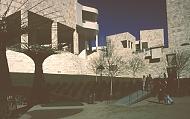 Santa Monica and the basin of Los Angeles and west to the Pacific Ocean. Curvilinear forms extending from essentially rectilinear structures echo contours of the site as well as more distant elements--the San Diego freeway below or the Pacific Ocean. Because of height restrictions, much of the Getty Center is underground and the six buildings are linked to each other at basement levels.
Santa Monica and the basin of Los Angeles and west to the Pacific Ocean. Curvilinear forms extending from essentially rectilinear structures echo contours of the site as well as more distant elements--the San Diego freeway below or the Pacific Ocean. Because of height restrictions, much of the Getty Center is underground and the six buildings are linked to each other at basement levels.
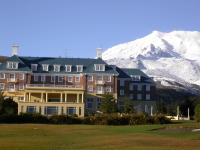 The Mount Ruapehu Bayview Chateau Tongariro is one of the most luxurious hotels in New Zealand. Whether you are here to Ski Mt Ruapehu or to enjoy fully guided walks through the Dual World Heritage Tongariro National Park, our luxury Chateau accommodation is New Zealand's perfect resort hotel, wedding and conference venue. Bayview Chateau Tongariro, nestled at the foot of Mount Ruapehu, was completed in 1929 and still retains many of its original features. It is one of New Zealand's few hotels located in a World Heritage Park.
The Mount Ruapehu Bayview Chateau Tongariro is one of the most luxurious hotels in New Zealand. Whether you are here to Ski Mt Ruapehu or to enjoy fully guided walks through the Dual World Heritage Tongariro National Park, our luxury Chateau accommodation is New Zealand's perfect resort hotel, wedding and conference venue. Bayview Chateau Tongariro, nestled at the foot of Mount Ruapehu, was completed in 1929 and still retains many of its original features. It is one of New Zealand's few hotels located in a World Heritage Park. 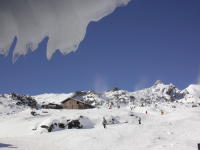 This hotel is within easy reach of the country's two largest cities, Auckland and Wellington. Renowned for its classical styling and grandeur, Bayview Chateau Tongariro is one of New Zealand's most famous buildings. Over the years, its facilities have been constantly updated to enhance many of its most endearing original features. The Chateau旅館是登Ruapehu山與滑雪的基地,它是法國式建築旅館,前是紐西蘭海拔最高的高爾夫球場(9-hole). Mt. Ruapehu是活火山其滑雪場是紐西蘭全島最大的滑雪勝地.
This hotel is within easy reach of the country's two largest cities, Auckland and Wellington. Renowned for its classical styling and grandeur, Bayview Chateau Tongariro is one of New Zealand's most famous buildings. Over the years, its facilities have been constantly updated to enhance many of its most endearing original features. The Chateau旅館是登Ruapehu山與滑雪的基地,它是法國式建築旅館,前是紐西蘭海拔最高的高爾夫球場(9-hole). Mt. Ruapehu是活火山其滑雪場是紐西蘭全島最大的滑雪勝地.
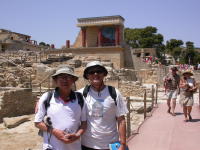 克里特島(Crete)位於地中海與愛琴海交界處,控制著歐、亞、非三大陸塊的經貿樞紐,在還沒成為希臘城邦之前,曾經是航海發達、不可一世的強權古國,勢力範圍遍及當時的地中海域. 希臘是歐洲古文明的發源地,克里特島的米諾安文明是最輝煌的時期,比起邁錫尼文明還要早數百年。克里特島上的克諾索斯皇宮,是目前出土足以代表米諾安文明光環的遺址,二十世紀初由英國考古學家亞瑟·伊凡斯從克里特島首府伊拉克裏翁東南方五公里處挖掘出來。依山傍河的克諾索斯皇宮,經證實建於西元前二零零零年,從開挖之初,目前還在陸續復建中。 克諾索斯皇宮又有
克里特島(Crete)位於地中海與愛琴海交界處,控制著歐、亞、非三大陸塊的經貿樞紐,在還沒成為希臘城邦之前,曾經是航海發達、不可一世的強權古國,勢力範圍遍及當時的地中海域. 希臘是歐洲古文明的發源地,克里特島的米諾安文明是最輝煌的時期,比起邁錫尼文明還要早數百年。克里特島上的克諾索斯皇宮,是目前出土足以代表米諾安文明光環的遺址,二十世紀初由英國考古學家亞瑟·伊凡斯從克里特島首府伊拉克裏翁東南方五公里處挖掘出來。依山傍河的克諾索斯皇宮,經證實建於西元前二零零零年,從開挖之初,目前還在陸續復建中。 克諾索斯皇宮又有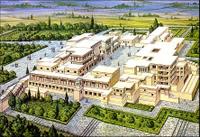 “牛怪迷宮”之稱,原來相傳統治著愛琴海的克裏特島的國王米諾斯,為鞏固海上霸權,曾經允諾送給海神波塞冬一頭公牛,後來卻因為公牛長相太美而反悔,波塞冬一怒之下,讓米諾斯王妃愛上公牛,並產下人身牛頭的牛怪米諾陶勒斯,米諾斯知道後非常憤怒,還在皇宮裏建造了迷宮關住牛怪。 說起來複雜的神話故事,卻讓克諾索斯皇宮變得更有可看性,透過已經傾倒的石柱廢墟,仍可想像迷宮般的建築和皇宮當年的輝煌燦爛。由於米諾安文明在建築藝術上有非常獨特的品位及修養,遊逛其中,益發有趣。 皇宮入口處墻上有一副赤裸上身、卷髮大眼的美男子“百合王子”像,其他值得走訪的焦點,還有國王房間墻面上的獅身鳥頭壁畫,以及皇后房間的海豚壁畫、貴賓室的花卉植物壁畫。目前,這些壁畫真跡都移至克裏特島上的伊拉克裏翁的考古博物館,但是現場細心複雜的倣古畫作,仍然讓人有身臨其境之感。
“牛怪迷宮”之稱,原來相傳統治著愛琴海的克裏特島的國王米諾斯,為鞏固海上霸權,曾經允諾送給海神波塞冬一頭公牛,後來卻因為公牛長相太美而反悔,波塞冬一怒之下,讓米諾斯王妃愛上公牛,並產下人身牛頭的牛怪米諾陶勒斯,米諾斯知道後非常憤怒,還在皇宮裏建造了迷宮關住牛怪。 說起來複雜的神話故事,卻讓克諾索斯皇宮變得更有可看性,透過已經傾倒的石柱廢墟,仍可想像迷宮般的建築和皇宮當年的輝煌燦爛。由於米諾安文明在建築藝術上有非常獨特的品位及修養,遊逛其中,益發有趣。 皇宮入口處墻上有一副赤裸上身、卷髮大眼的美男子“百合王子”像,其他值得走訪的焦點,還有國王房間墻面上的獅身鳥頭壁畫,以及皇后房間的海豚壁畫、貴賓室的花卉植物壁畫。目前,這些壁畫真跡都移至克裏特島上的伊拉克裏翁的考古博物館,但是現場細心複雜的倣古畫作,仍然讓人有身臨其境之感。
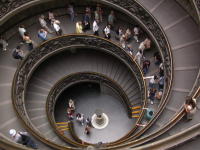 梵蒂岡美術館入口--1932年由 Giuseppe Momo 所設計。這不只是旋轉梯,還是交錯式的,一邊往上攀升至美術館,一邊則導引您下降至出口,非常特別;可能會在雜誌媒體上常常看到跟這張類似的照片。
梵蒂岡美術館入口--1932年由 Giuseppe Momo 所設計。這不只是旋轉梯,還是交錯式的,一邊往上攀升至美術館,一邊則導引您下降至出口,非常特別;可能會在雜誌媒體上常常看到跟這張類似的照片。